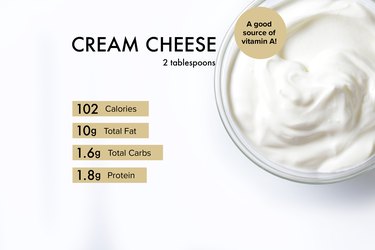
Cream cheese is often associated with bagels or cheesecake and conjures images of a luscious and tasty treat. It spreads smoothly with a light and slightly tangy flavor.
Cream cheese is made with pasteurized cream or a combo of milk and cream. The pH-lowering lactic acid bacteria is added in, which produces curds, and then the whey gets strained, the cheese undergoes heat treatment and additives are mixed in to improve the texture. In the U.S., the FDA requires cream cheese's minimum milkfat content to be 33 percent and the maximum moisture content to be 55 percent.
Video of the Day
Video of the Day
The beloved dairy product can be found in a variety of forms, including regular, whipped, brick, low-fat and fat-free. Flavors such as vegetable, chive and strawberry are also widely available, as is Neufchâtel cheese.
Cream Cheese vs. Neufchâtel
Real French Neufchâtel is made with raw cow’s milk and has a rind like Brie. However, the type you spot next to the cream cheese in the dairy aisle is made with pasteurized dairy and is more like a low-fat cream cheese product. The FDA requires American Neufchâtel to have milkfat around 20 to 30 percent milkfat and a maximum moisture content of 65 percent.
Cream Cheese Nutrition Facts
Two tablespoons (about 30 grams) of cream cheese is equal to a single serving. One serving of regular cream cheese contains:
- Calories: 102
- Total fat: 10 g
- Cholesterol: 29 mg
- Sodium: 91 mg
- Total carbs: 1.6 g
- Dietary fiber: 0 g
- Sugar: 1 g
- Added sugar: 0 g
- Protein: 1.8 g
How Different Types of Cream Cheeses Compare
Whipped and low-fat cream cheeses contain fewer calories and grams of fat, while flavored cream cheeses often contain more calories from sugar.
Cream Cheese Macros
- Total fat: One serving of cream cheese has 10 grams of total fat, which includes 2.6 grams of monounsaturated fats, 0.4 grams of polyunsaturated fat, 5.8 grams saturated fat and 0.4 grams of trans fat.
- Carbohydrates: One serving of cream cheese has 1.6 grams of carbs, which includes 0 grams of fiber and 1 gram of natural sugars.
- Protein: One serving of cream cheese has 1.8 grams of protein.
Vitamins, Minerals and Other Micronutrients
- Vitamin A: 10% of your Daily Value (DV)
- Vitamin B2: 5% DV
- Selenium: 4% DV
- Vitamin B12: 3% DV
- Vitamin B5: 3% DV
- Two tablespoons of cream cheese is not a significant source of vitamin E (2% DV), phosphorus (2% DV), calcium (2% DV), magnesium (1% DV), zinc (1% DV), copper (1% DV) or potassium (1% DV).
Health Benefits of Cream Cheese
Cream cheese doesn't provide as much calcium and protein as many hard cheeses, but does have some redeeming qualities.
1. The Vitamin A in Cream Cheese Is Linked to Promoting Good Vision
Cream cheese is a good source of vitamin A, which is integral to eye health. It is critical to healthy eyesight and helps prevent vision-related issues, including night blindness, according to the National Institutes of Health.
With 10 percent of our recommended daily value found in only two tablespoons, cream cheese packs a powerful punch.
Bonus: Vitamin A is fat-soluble, which means your body is able to better absorb it when it's paired with fats — so opt for low-fat or full-fat cream cheese, or pair the cheese with a source of fats such as eggs, to help your body get the most vitamin A.
2. It May Be OK for People With Lactose Intolerance
Those with lactose intolerance will be delighted to learn that a serving of cream cheese likely won't cause GI discomfort.
Cream cheese has about 1 gram of lactose, according to the University of Virginia. That's not a lot — in fact, most people with lactose intolerance can tolerate around 12 to 15 grams of lactose (about the amount in an 8-ounce glass of milk), according to a June 2010 review in the Annals of Internal Medicine.
Which Is Healthier, Butter or Cream Cheese?
The same one-ounce serving of unsalted butter could be considered as less healthy than cream cheese. It has twice the calories, more than twice the saturated fat and less protein.
Cream Cheese Potential Health Risks
Food Allergies
Dairy can cause either a food allergy or food intolerance in some people. While these may produce similar symptoms, they're not the same.
Here's the difference: An allergy to dairy is the body's immune response to the protein found in cow's milk, which is the result of inadequate lactase. Lactase, the enzyme that breaks down lactose, is the natural sugar in cow's milk. Other symptoms may include hives, cramps, wheezing, vomiting or a rash. An allergy to dairy may be life-threatening depending on the severity of the allergic reaction.
Both a dairy allergy and dairy intolerance may lead to feeling gassy, bloated, nauseous or experiencing diarrhea, according to Harvard Health Publishing.
Related Reading
Drug Interactions
While cream cheese is not known to interact with any medication, be sure to discuss any food interactions with your medical professional.
Cream Cheese Brands We Love
- Belle Chèvre Cream Cheese ($3.99 per container on Bellechevre.com)
- Organic Valley Cream Cheese ($3.99 per container on Freshdirect.com)
- Kraft Philadelphia Whipped Plain Cream Cheese Spread ($6.50 per container on Amazon.com)

Cream Cheese Preparation and Useful Tips
Cream cheese is always available at your local grocery all year-round. It's versatile and makes for a delicious toast or taco topper as well as an ingredient in a variety of recipes. Here are some creative ways to use it:
- Use as a base for a variety of dips, including onion dip, taco dip and spinach artichoke dip.
- Use for a variety of sweet dishes and baked goods, including cheesecake, brownies, cake, muffins and cookies. Cream cheese can be part of the baked good or as a glaze or frosting.
- Add to macaroni and cheese or other cheesy pastas for a creamier texture.
- Mix into mashed potatoes to add creaminess and tang.
- Use
as part of a cheese ball appetizer.
- Use as an ingredient in pancake or waffle batter.
- Use as a filling for crepes.
- Mix with frozen spinach and use as a filling for calzones or hand pies.
- Use as an ingredient in creamy salads, such as chicken, egg or potato salad.
- Use it to add creaminess to soup, such as chowder or bisque.
- Use as part of a stuffing for baked appetizers such as stuffed mushrooms and phyllo cups.
Recipes Using Cream Cheese
Alternatives to Cream Cheese
In place of cream cheese, other tangy dairy items can be used. However, the alternative depends in part on what dish you are making.
As a savory spread: Ricotta, cottage cheese, mascarpone and plain Greek yogurt are easy swap-outs to help you cut back on calories and add value, like protein and calcium.
For sweet dishes: Ricotta and mascarpone are generally the best alternatives to cream cheese.
For dairy-free options: There are a variety of dairy-free cream cheese alternatives (such as Daiya's cream cheese alternative) available nationwide.
- My Food Data: “Cream Cheese”
- NIH: “Vitamin A Fact Sheet for Health Professionals”
- Harvard Health Publishing: “Living with lactose intolerance”
- My Food Data: "Unsalted Butter"
- Annals of Internal Medicine: "Systematic Review: Effective Management Strategies for Lactose Intolerance"
- University of Virginia: "Lactose Content of Common Dairy Foods"
- FDA: "Code of Federal Regulations Title 21: Neufchâtel"
- FDA: "FDA: "Code of Federal Regulations Title 21: Cream Cheese"